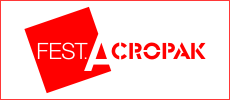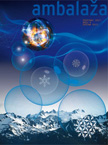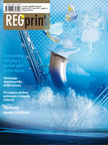«
Back to content
Vol 2 | Year 2017

B. Jablonowski: Digitalization, Industry 4.0. and Sustainability are the Main Trends
At this year interpack Save Food played a big role – as an international congress on the first day of the trade fair and at the innovationparc, a special show with solutions aimed at reducing food losses and food waste. Interpack also presented the new industrial revolution in packaging industry at Industry 4.0. special show. Once again, interpack more than lived up to its role as the leading international trade fair for the packaging sector.
This year’s world’s largest trade fair of the packaging sector and related process industries, interpack 2017 was held from May 4 – 10, with record attendance of 2,865 companies. As Bernd Jablonowski told us in the interview, Interpack 2017 went extremely well, especially from the exhibitors point of view. Namely, 74 % visitors travelled to Düsseldorf from abroad and three-quarters of them were decision-makers. Focus of this year’s fair was on Save Food initiative and Industry 4.0. in packaging sector. With Bernd Jablonowski we have talked about last edition of interpack, trends in packaging industry and globaly very important Save Food initiative.
Interpack 2017 is behind us. There are numerous reasons for satisfaction. At the very beginning, please tell us your impressions as a director.
We had already seen some very good signs ahead of interpack 2017. Never before had we experienced such strong exhibitor demand, with the result that, at the time of the official registration deadline at the end of February 2016, interpack had been over booked by 20 per cent and so even more than at previous events. Ultimately, some 2,865 companies exhibited – a record number. Just as we had expected based on those early signs, interpack 2017 went extremely well. We’ve heard nothing but good things from the exhibitors, especially about the quality of the visitors from around the world and their readiness to place orders. Once again, interpack more than lived up to its role as the leading international trade fair for the packaging sector and related process industries.
The numbers show that this year’s interpack breaks many records so please give us some technical data.
The very high share of 74 per cent of visitors travelling to the event from outside Germany was particularly striking. Professionals involved in making decisions at their companies were strongly represented among visitors; three out of four respondents said so in the official surveys. What’s more, 98 per cent of visitors were satisfied or even very satisfied with interpack 2017.
In your opinion, what is the main reason for interpack 2017 drawing in such a record number of exhibitors? Does it mean that the industry is waking up and that the crisis and recession is forgotten?
Interpack has an international focus, which means the world market is reflected at the trade fair. While the consequences of the economic and financial crisis could already be felt at the previous events for that very reason, they’d been ameliorated in part by positive or at least neutral developments in other markets. International industry data ahead of interpack 2017 was very promising. Demand for packaged foods continues to edge up, especially in the emerging markets in Asia. And the companies exhibiting at interpack offer the technology to help meet that demand.
What was the structure of exhibitors? What segment of the packaging industry was representing most? What is the ratio when we speak about the types of packaging materials?
Suppliers of equipment and process technology for packaging foods or goods traditionally make up the biggest contingent at interpack. Companies from this segment filled ten halls. Equipment and process technology specifically for sweets and pastry were on display in four halls, while suppliers of packaging media and packaging materials, as well as producers of packaging media, occupied six halls. We saw an increase of about 8 per cent in the packaging means segment compared to interpack 2014. All classes of packaging means are represented at interpack. In line with their global market share, plastic and paper/cardboard are most prominent.
Interpack can be surely called a kind of inspirational fair for packaging industry. What was the focus of this year’s fair?
Among our special features, SAVE FOOD played a big role again – as an international congress on the first day of the trade fair and at the innovationparc, a special show with solutions aimed at reducing food losses and food waste. We also introduced the new Industry 4.0 special show, which we implemented in cooperation with the German Engineering Federation VDMA. It was very well received by visitors.
What does the notion of Industry 4.0.mean for packaging industry, what are other novelties? Are packagers ready for the new industrial revolution?
There’s no complete consensus right now about every last detail of Industry 4.0. What’s certain, though, is that the digitalisation and networking of technology keeps getting more and more important for the packaging sector and related process industries, as well. This was on vivid display at interpack 2017.
Considering all that was shown at the fair, what would you say are the main trends in packaging industry?
There are several global societal trends that impact the food industry, among others, and thus also affect the packaging industry. These include the growing number of single-family households, increasingly diverse and rapidly changing varieties, and the trend towards individualisation. In order to manufacture products like that in just the right packaging, machinery and equipment must become more and more flexible. This is precisely what drives digitalisation, which in turn paves the way for such things as batch sizes of 1, i.e. the most personalised option available.
Fast technological development undoubtedly imposes and changes trends and habits in all segments, including packaging industry. What are to your mind main challenges facing packaging industry in the next couple of years, until the next interpack let’s say?
Packaging must meet a huge number of requirements, especially in the food industry, which is the biggest buyer of packaging – and sometimes these requirements seem diametrically opposed to each other. Besides protecting the contents, an attractive design and maximum ease of handling – if possible with convenience elements – are also mandatory. But all that mustn’t cost very much and should be as sustainable as possible. In this case, too, machines featuring highly automated, sensor- and microprocessor-controlled drive technology and innovative materials are the keys to getting better and better at mastering this balancing act.
For the third year in a row, Save Food initiative was presented within interpack, i.e. innovationparc. Can you please tell us what has been achieved so far with this initiative and are you satisfied with the response it received within both companies and respective institutions?
We launched Save Food six years ago at interpack 2011 with a congress and a special show. We’ve been cooperating with the Food and Agriculture Organization of the United Nations (FAO) from the very beginning. That’s why this launch garnered so much attention at the time, by the way. And fortunately we’ve been able to sustain that initial momentum and set up a long-term partnership with the FAO – just now at interpack we signed a second Memorandum of Understanding for the coming years. In addition, the United Nations Environment Programme (UNEP) got on board as a partner in 2013. By now, Save Food has grown into one of the largest initiatives of its kind worldwide, with more than 850 international members from industry, associations, non-governmental organisations and research institutes. A number of projects are being implemented under the Save Food banner. Member contributions recently funded a study that examined losses of certain staple foods in India in order to find possible ways to reduce such waste. In an ideal scenario, this could also make for some interesting business cases for member companies.
Save Food Congress was held on the first day of interpack. What was discussed at the Congress? What were the main topics? Was the further strategy of Save Food initiative development established?
We chose a multidimensional approach for the Congress so the discussion could cover everything from very concrete best practices to a broad view of the problem. For example, Kostas G. Stamoulis, Assistant Director-General of the FAO’s Economic and Social Development Department, in his lecture focused on the challenges of feeding the world in the 21st century. The keynote speech at the conference was delivered by Vytenis Andriukaitis, EU Commissioner for Health and Food Safety in Europe. India was one of the focal themes of the Congress. The study I just mentioned was presented in that context, and Gargi Kaul, Joint Secretary & Financial Adviser at the Indian Ministry of Food Processing Industries, spoke about opportunities for this sector in her country. The share of foods processed to increase shelf life and protect against spoilage is still relatively low in India. In the big picture, the Congress is aimed at enabling an interdisciplinary exchange of ideas between all involved parties, with the hope of paving the way for concrete measures. We’re pursuing a similar objective with the Save Food meetings we organize in cooperation with a partner from the industry in non-interpack years.
Save Food packaging solutions awarded within national competitions of World Packaging Organistion (WPO) members were presented within the innovationparc. What was the goal of the exhibition and what were the reactions of exhibitors and visitors?
As part of its prestigious WorldStar Awards, the WPO used the occasion of this year’s interpack to award a prize in the Save Food category for the first time. Accordingly, the group introduced solutions to help curb food losses and food waste at its innovationparc stand and at the Congress. One example: fruit bags that absorb ripening gases, thus prolonging the shelf life of their contents. Since customers increasingly care about sustainability, a solution such as this one can turn into a genuine competitive advantage. The Save Food theme is also well-suited to show consumers that sustainability doesn’t just mean packaging that is as eco-friendly as possible. It also means packaging whose protective function optimally preserves resources. Generally, after all, it takes far more resources to produce the content than the packaging. It goes without saying that visitors really enjoy such a presentation of very concrete solutions, like the participants in the WorldStar Award.
Considering current tempo around us, May 2020 will be here soon. What would be your recommendations to packaging community to follow until the next interpack?
I think that digitalisation and Industry 4.0 are themes that will have a much greater presence at the next interpack. That means technology providers will have to do quite a bit of development work until then. Sustainability is going to continue to dominate the materials side of the equation. The goal is to use fewer and fewer packaging materials while keeping stability the same. In addition, a greater selection of alternative materials will become available.
Interview by: Željka Livaić
Interpack 2017 is behind us. There are numerous reasons for satisfaction. At the very beginning, please tell us your impressions as a director.
We had already seen some very good signs ahead of interpack 2017. Never before had we experienced such strong exhibitor demand, with the result that, at the time of the official registration deadline at the end of February 2016, interpack had been over booked by 20 per cent and so even more than at previous events. Ultimately, some 2,865 companies exhibited – a record number. Just as we had expected based on those early signs, interpack 2017 went extremely well. We’ve heard nothing but good things from the exhibitors, especially about the quality of the visitors from around the world and their readiness to place orders. Once again, interpack more than lived up to its role as the leading international trade fair for the packaging sector and related process industries.
The numbers show that this year’s interpack breaks many records so please give us some technical data.
The very high share of 74 per cent of visitors travelling to the event from outside Germany was particularly striking. Professionals involved in making decisions at their companies were strongly represented among visitors; three out of four respondents said so in the official surveys. What’s more, 98 per cent of visitors were satisfied or even very satisfied with interpack 2017.
Digitalisation and networking of technology keeps getting more and more important for the packaging sector
In your opinion, what is the main reason for interpack 2017 drawing in such a record number of exhibitors? Does it mean that the industry is waking up and that the crisis and recession is forgotten?
Interpack has an international focus, which means the world market is reflected at the trade fair. While the consequences of the economic and financial crisis could already be felt at the previous events for that very reason, they’d been ameliorated in part by positive or at least neutral developments in other markets. International industry data ahead of interpack 2017 was very promising. Demand for packaged foods continues to edge up, especially in the emerging markets in Asia. And the companies exhibiting at interpack offer the technology to help meet that demand.
What was the structure of exhibitors? What segment of the packaging industry was representing most? What is the ratio when we speak about the types of packaging materials?
Suppliers of equipment and process technology for packaging foods or goods traditionally make up the biggest contingent at interpack. Companies from this segment filled ten halls. Equipment and process technology specifically for sweets and pastry were on display in four halls, while suppliers of packaging media and packaging materials, as well as producers of packaging media, occupied six halls. We saw an increase of about 8 per cent in the packaging means segment compared to interpack 2014. All classes of packaging means are represented at interpack. In line with their global market share, plastic and paper/cardboard are most prominent.
Interpack can be surely called a kind of inspirational fair for packaging industry. What was the focus of this year’s fair?
Among our special features, SAVE FOOD played a big role again – as an international congress on the first day of the trade fair and at the innovationparc, a special show with solutions aimed at reducing food losses and food waste. We also introduced the new Industry 4.0 special show, which we implemented in cooperation with the German Engineering Federation VDMA. It was very well received by visitors.
What does the notion of Industry 4.0.mean for packaging industry, what are other novelties? Are packagers ready for the new industrial revolution?
There’s no complete consensus right now about every last detail of Industry 4.0. What’s certain, though, is that the digitalisation and networking of technology keeps getting more and more important for the packaging sector and related process industries, as well. This was on vivid display at interpack 2017.
Sustainability doesn’t just mean packaging that is eco-friendly, it also means packaging whose protective function optimally preserves resources
Considering all that was shown at the fair, what would you say are the main trends in packaging industry?
There are several global societal trends that impact the food industry, among others, and thus also affect the packaging industry. These include the growing number of single-family households, increasingly diverse and rapidly changing varieties, and the trend towards individualisation. In order to manufacture products like that in just the right packaging, machinery and equipment must become more and more flexible. This is precisely what drives digitalisation, which in turn paves the way for such things as batch sizes of 1, i.e. the most personalised option available.
Fast technological development undoubtedly imposes and changes trends and habits in all segments, including packaging industry. What are to your mind main challenges facing packaging industry in the next couple of years, until the next interpack let’s say?
Packaging must meet a huge number of requirements, especially in the food industry, which is the biggest buyer of packaging – and sometimes these requirements seem diametrically opposed to each other. Besides protecting the contents, an attractive design and maximum ease of handling – if possible with convenience elements – are also mandatory. But all that mustn’t cost very much and should be as sustainable as possible. In this case, too, machines featuring highly automated, sensor- and microprocessor-controlled drive technology and innovative materials are the keys to getting better and better at mastering this balancing act.
For the third year in a row, Save Food initiative was presented within interpack, i.e. innovationparc. Can you please tell us what has been achieved so far with this initiative and are you satisfied with the response it received within both companies and respective institutions?
We launched Save Food six years ago at interpack 2011 with a congress and a special show. We’ve been cooperating with the Food and Agriculture Organization of the United Nations (FAO) from the very beginning. That’s why this launch garnered so much attention at the time, by the way. And fortunately we’ve been able to sustain that initial momentum and set up a long-term partnership with the FAO – just now at interpack we signed a second Memorandum of Understanding for the coming years. In addition, the United Nations Environment Programme (UNEP) got on board as a partner in 2013. By now, Save Food has grown into one of the largest initiatives of its kind worldwide, with more than 850 international members from industry, associations, non-governmental organisations and research institutes. A number of projects are being implemented under the Save Food banner. Member contributions recently funded a study that examined losses of certain staple foods in India in order to find possible ways to reduce such waste. In an ideal scenario, this could also make for some interesting business cases for member companies.
Save Food Congress was held on the first day of interpack. What was discussed at the Congress? What were the main topics? Was the further strategy of Save Food initiative development established?
We chose a multidimensional approach for the Congress so the discussion could cover everything from very concrete best practices to a broad view of the problem. For example, Kostas G. Stamoulis, Assistant Director-General of the FAO’s Economic and Social Development Department, in his lecture focused on the challenges of feeding the world in the 21st century. The keynote speech at the conference was delivered by Vytenis Andriukaitis, EU Commissioner for Health and Food Safety in Europe. India was one of the focal themes of the Congress. The study I just mentioned was presented in that context, and Gargi Kaul, Joint Secretary & Financial Adviser at the Indian Ministry of Food Processing Industries, spoke about opportunities for this sector in her country. The share of foods processed to increase shelf life and protect against spoilage is still relatively low in India. In the big picture, the Congress is aimed at enabling an interdisciplinary exchange of ideas between all involved parties, with the hope of paving the way for concrete measures. We’re pursuing a similar objective with the Save Food meetings we organize in cooperation with a partner from the industry in non-interpack years.
Save Food packaging solutions awarded within national competitions of World Packaging Organistion (WPO) members were presented within the innovationparc. What was the goal of the exhibition and what were the reactions of exhibitors and visitors?
As part of its prestigious WorldStar Awards, the WPO used the occasion of this year’s interpack to award a prize in the Save Food category for the first time. Accordingly, the group introduced solutions to help curb food losses and food waste at its innovationparc stand and at the Congress. One example: fruit bags that absorb ripening gases, thus prolonging the shelf life of their contents. Since customers increasingly care about sustainability, a solution such as this one can turn into a genuine competitive advantage. The Save Food theme is also well-suited to show consumers that sustainability doesn’t just mean packaging that is as eco-friendly as possible. It also means packaging whose protective function optimally preserves resources. Generally, after all, it takes far more resources to produce the content than the packaging. It goes without saying that visitors really enjoy such a presentation of very concrete solutions, like the participants in the WorldStar Award.
Considering current tempo around us, May 2020 will be here soon. What would be your recommendations to packaging community to follow until the next interpack?
I think that digitalisation and Industry 4.0 are themes that will have a much greater presence at the next interpack. That means technology providers will have to do quite a bit of development work until then. Sustainability is going to continue to dominate the materials side of the equation. The goal is to use fewer and fewer packaging materials while keeping stability the same. In addition, a greater selection of alternative materials will become available.
Interview by: Željka Livaić
















